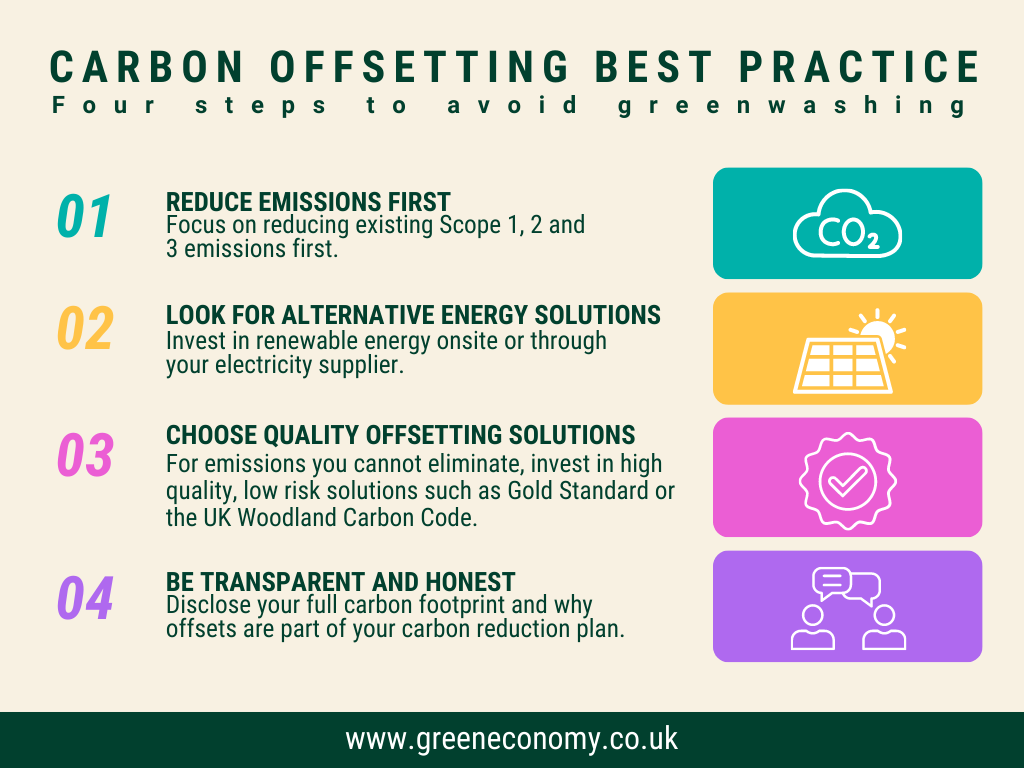
A business guide to carbon offsetting
Read time: 5 minutes
When looking to reduce emissions from your operation, carbon offsetting appears an attractive quick fix. Here we explore how carbon offsetting works, when it can be effective and why it should be the final item on your carbon reduction to-do list.
Carbon offsetting is a huge industry. At the click of a button, you can now choose to offset your emissions when booking a flight, paying for a meal in a restaurant, or even offset your entire carbon footprint in one go. It sounds straightforward: when you undertake an activity that generates greenhouse gas emissions, you pay for the equivalent emissions to be removed somewhere else, so your impact is balanced out.
But things are a little more complicated under the surface. Used responsibly, offsets can be an effective part of your carbon reduction strategy, but there are many reasons to tread carefully. This guide assumes a basic understanding of what a carbon footprint is. If you aren’t at this stage yet, read our guide to carbon foot printing first.
A business guide to carbon footprinting
When you purchase a carbon offset, what you are actually buying are ‘credits’ which have been generated and sold by a project that either removes carbon from the atmosphere or prevent emissions from being produced.
There are a huge variety of different methods used to generate offset credits, from natural means, such as tree planting or peatland restoration (which absorb and lock away carbon), to technological means such as renewable energy projects.
For every tonne of carbon saved, a carbon offset credit can be created and sold on the market. The purchaser then effectively ‘retires’ the credit so that it can claim the saving towards its own carbon reduction target.
To ensure their credibility, credits must be monitored and verified by a third-party to ensure that:
Offsetting has an important role to play in tackling climate change. In fact, we cannot reach net zero emissions without it.
From a climate perspective, it doesn’t matter where emissions reductions take place – a tonne of carbon emitted in Bolton is the same as a tonne of carbon emitted anywhere else in the world. That means, at least in theory, that organisations can pursue carbon reductions wherever they are most cost-effective and appropriate.
For example, if a company has an emissions-producing manufacturing process that is prohibitively expensive to change, or has no proven alternative, then carbon offsetting provides a way to balance out the impact until a viable or affordable solution becomes available.
Offsets can also be useful for neutralising the parts of your carbon footprint that you have limited influence over, such as your Scope 3 emissions. In addition, high quality offsetting projects are often designed to provide additional social and environmental benefits where they are located, such as employment or education opportunities, and can therefore contribute to wider social responsibility commitments.
While it can be tempting to jump into carbon offsetting straight away, there are several key reasons why it should be the last consideration on your carbon reduction journey.
The science of offsetting is inherently uncertain. It’s impossible to guarantee how much carbon a planted tree will lock away, or at what rate. Nor can we guarantee that a tree will reach its expected lifespan – it might die of disease or burn in a wildfire. Similarly, we can’t know for sure how much carbon will be saved by installing solar panels on someone’s home. The higher quality the offset the better, but ultimately all offsets are educated guesses.
Offsetting without first attempting to reduce your emissions will lead to missed opportunities to benefit your business. Preventing emissions in the first place, for example through energy efficiency, will not only reduce your carbon footprint but also provide other benefits such as reduced costs, less reliance on external energy providers, improved productivity and a better working environment for staff. Spending money on offsetting provides no such benefit.
Relying too much on offsetting could leave you open to accusations of ‘greenwashing’. At best, it could mislead stakeholders by giving the impression that your work is done when little progress may have been made in reality. At worst, it could be seen as shirking responsibility for your own actions by simply putting the burden of your carbon footprint onto someone else.
Cheap, low quality offsets can sometimes do more harm than good. For example, in the past, huge mono-plantation forestry schemes in developing countries have been found to have pushed local communities off the land and damaged biodiversity.
Some standards and climate commitments do not recognise offsetting as a direct contribution to emissions reductions. For example, the Science Based Targets initiative requires that companies deliver emissions reductions through direct action within their own operations or value chain and does not allow offsets to be counted towards targets.


When considering carbon offsets, follow these principles:
Prioritise minimising your carbon footprint as much as possible. As a rule of thumb, focus on reducing your Scope 1 and 2 emissions.
Explore ways to reduce these emissions further by investing in on-site renewable energy and/or renewable electricity supply. You should only use offsets for the emissions you cannot eliminate yourself.
Use high quality, low risk offsets that are verified to a respected standard, such as the Gold Standard (others are available). If investing in UK woodland projects, make sure they are verified to the UK Woodland Carbon Code.
Be transparent with your stakeholders by disclosing your full carbon footprint and explaining how and why offsets are being used as part of your carbon reduction plan.
Here is a good example of how to communicate offsets, written by WWF:
“Recognising that we still have work to do to reduce our emissions footprint, we are taking X and Y steps to advance toward our goal of becoming an emissions free company. Although we are unable to eliminate certain emissions at this time, we have purchased carbon credits equivalent to the emissions we haven’t yet been able to eliminate. These credits will finance much-needed climate mitigation action and support the global transition to a zero carbon future and represent a temporary measure until we are able to undertake the steps needed to eliminate our emissions entirely.”
Green Economy is here to help you reduce emissions. Our specialist advisors can review your business to identify the most effective measures and provide support to minimise your need for carbon offsetting.